Round-up: 4 rockabilly-style semi-acoustic electric guitars
Affordable fifties-inspired semis reviewed, compared
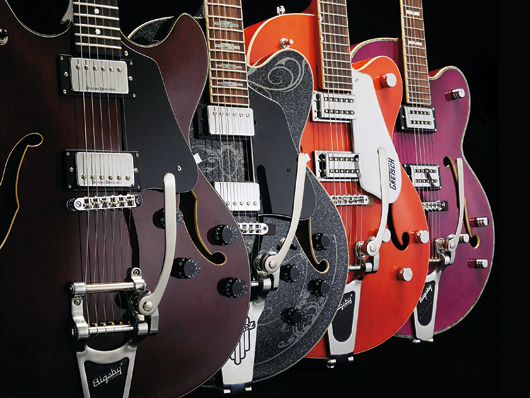
4 rockabilly-style semi-acoustic electric guitars
When approaching certain styles of music the choice of gear can be overwhelming. If you want to rock out Scotty Moore's sultry licks, the kinetic styles of Eddie Cochran and Bill Flagg, or the more country-slanted flavours of Jim Horton, for example, what guitar or amp do you buy?
There’s only one choice of guitar, on paper at least: Gretsch.
Anyone interested in such styles will know that the rig to aspire to comprises a Gretsch G6120 Chet Atkins, a Space Echo and a vintage Fender amp, preferably a tweed Bassman. Sadly though, the cost of such a set-up is painful; you’re talking the thick end of £4000. And great though the equipment in question is, that’s a huge investment to undertake, especially if you’re snagged in the current financial whirlpool.
Rock ’n’ roll fire with hillbilly rhythms
One of the reasons that Gretsch became so closely associated with rockabilly, the combination of rock ’n’ roll fire with hillbilly rhythms, is simple: there really wasn’t much else available in 1955.
Of course, it’s possible to obtain a convincing fifties-style sound out of virtually any guitar and amp combination assuming you have the know how and chops, but even a Gibson ES isn’t close enough to the correct look: how much cooler would Marty McFly have been if he’d roasted Back To The Future’s Enchantment Under The Sea dance sporting a 6120 rather than the ES-345 he memorably touted?
Anything that’s too modern will set alarm bells ringing with gusto: you’ll have a hard job convincing the notoriously picky UK rockabilly fraternity of your validity if you front a Stray Cats tribute band while grasping an Ibanez JEM, irrespective of how good your licks might be.
Quiffs, blackjacks and soda fountains
To answer at least part of the problem, we’ve cast our net over the choppy commercial seas to ensnare a choice of four contemporary semis from varying price points that certainly tick all the right boxes in the looks department. One is a new addition to the Gretsch Electromatic line, but the remainder come from very familiar companies not so intimately linked with quiffs, blackjacks and soda fountains.
First up: Schecter Corsair price and specification
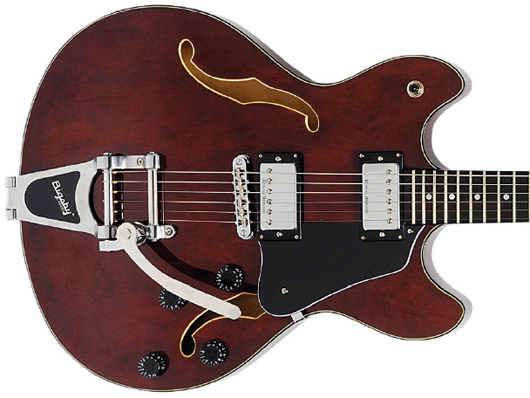
Schecter Corsair specifications
Spec
Price: £849
Origin: Korea
Body: Laminated maple with laminated maple top
Neck: Mahogany, set
Fingerboard: Ebony
Hardware: Bigsby B70 vibrato, tune-o-matic-style bridge
Electrics: Two Duncan Designed HB-101 humbuckers, three-way toggle pickup selector, two volumes and two tone controls each with a push/pull coil-tap
Options: The hardtail version cost £769; Cure guitarist Porl Thompson’s signature Corsair retails at £999
Finishes: Gloss walnut (as reviewed), black
Next: Schecter Corsair build and features
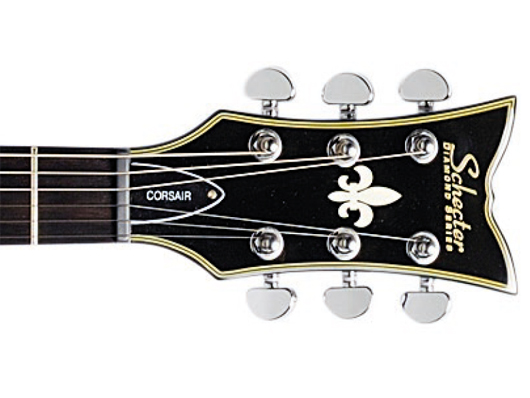
Schecter Corsair build and features
Build and features
As well as being the only double-cut of our quartet, the Corsair is also the only one to possess a full-length centre block, made from solid mahogany, even though the remainder of the body (43mm thick at the rim) is a laminated maple affair. And we absolutely love the old school gloss walnut finish on our example.
The two horns are sharper than those of a Gibson ES-335 or Gretsch White Falcon, and the four controls are clustered around the lower f-hole, which, again, isn’t necessarily a traditional arrangement.
Pickups comprise a pair of Duncan Designed HB-101, (based on Seymour Duncan’s classic ’59), and both tone controls double as a coil-split, upping the guitar’s versatility stakes considerably.
The vibrato is Bigsby’s standard model designed for use on such slimline semis - the B70 - and Schecter has made the very sensible decision to equip the Corsair with a fixed, rather than floating, tune-omatic-style bridge.
Demonstrating a comfortable and modern feel, the set mahogany neck and ebony ’board puts up nary a fight - a good thing considering how unstable vintage semis can be - and the headstock sports a three-a-side arrangement of Gotoh tuners.
Next: Schecter Corsair sounds, pros and cons
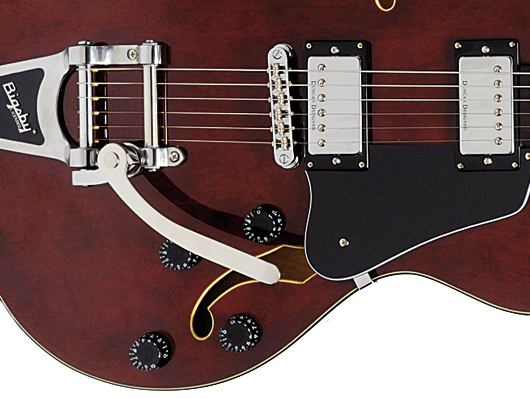
Schecter Corsair sounds, pros and cons
Sounds
The overall tone benefits richly from the centre block here, with all six pickup selections daubed in woody warmth. For rockabilly styles we found we reached for the treble pickup’s coil-split more often than not, as the subsequent tone cuts and zings with alacrity. The neck pickup oozes woody warmth and depth though retains meat and articulation enough for gainier blues and rock styles.
Bridge then neck pickups:
Pros: Quality build and finish; sleek neck; wide choice of tones.
Cons: Aside from the price, very little.
4 out of 5
Verdict: It blurs the line between a blues and rockabilly guitar, but it’s an impressive instrument.
Next: Gretsch G5120 Electromatic price and specification
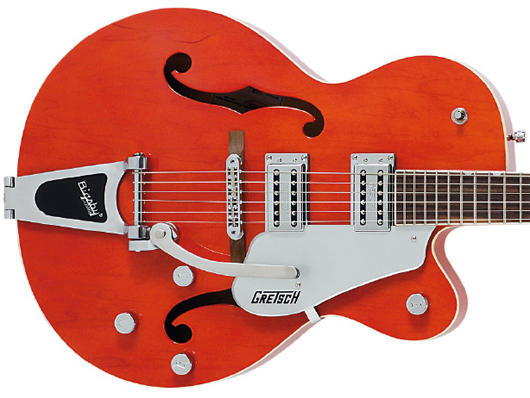
Gretsch G5120 Electromatic specification
Spec
Price: £659.99
Origin: Korea
Body: Laminated maple with laminated maple top
Neck: Maple, set
Fingerboard: Rosewood
Hardware: Licensed Bigsby B60 vibrato, adjust-o-matic bridge with rosewood base
Electrics: Two Gretsch Electromatic humbuckers, three-way toggle pickup selector, volume control for each pickup plus master tone and master volume
Options: The double-cut version, the G5122DC, costs £699
Finishes: Orange (as reviewed)
Next: Gretsch G5120 Electromatic build and features
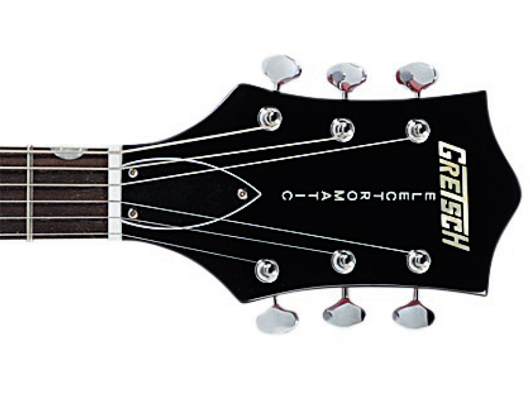
Gretsch G5120 Electromatic build and features
Build and features
We should say from the off that our experiences of the Gretsch Electromatic range over the years have been rather mixed. Instead of us being able to regard it as a genuine alternative to the more expensive Professional Collection Gretsches, the examples we’ve played haven’t always impressed.
Happily that’s all changed - this G5120 is a genuinely wonderful guitar that possess the just right vibe, feel and look - even though this version of the Western orange stain is a tad on the red side to our eyes.
The pickups comprise a pair of vintage-styled humbuckers, which are hot off the Gretsch drawing board, while the licensed Bigsby B60 vibrato works in tandem with a floating adjust-o-matic bridge. Here the three bass-side saddles are sited in the opposite direction to those of a traditional tune-o-matic in order to further aid stability when the strings move with the vibrato.
Put simply, we’d be hard pressed to distinguish this from a G6120 in a blindfold test - high praise indeed…
Next: Gretsch G5120 Electromatic sounds, pros and cons
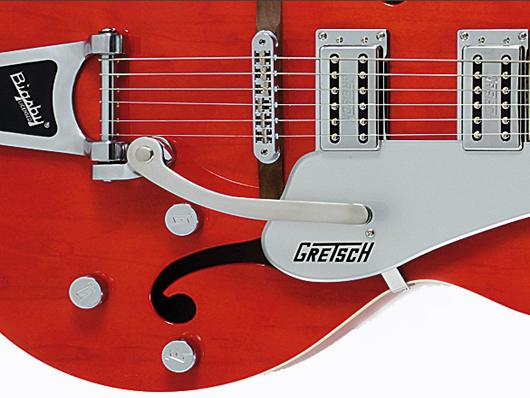
Gretsch G5120 Electromatic sounds, pros and cons
Sounds
In fact, the most obvious difference here is the sound. That’s not saying the G5120 doesn’t have a nice smooth voice, as even the treble pickup offers an exceedingly warm, expressive tone, but it’s missing some Filter’Tron-powered twang.
This can be countered by an external EQ device or upping your amp’s treble but it’s not quite as convincing as a G6120: it’s not as acoustically resonant either. That said, it’s easily the slinkiest player of the lot and the Bigsby, which has been set-up to perfection, is as stable as such a contraption can reasonably expect to be.
Bridge then neck pickups:
Pros: Authenticity; build quality; tone.
Cons: At this price, nothing about the guitar, though a gigbag would be nice.
4.5 out of 5
Verdict: If this is anything to go by, the Electromatic range is now a serious affordable alternative to a ‘real’ Gretsch.
Next: Peavey Rockingham B6 price and specification
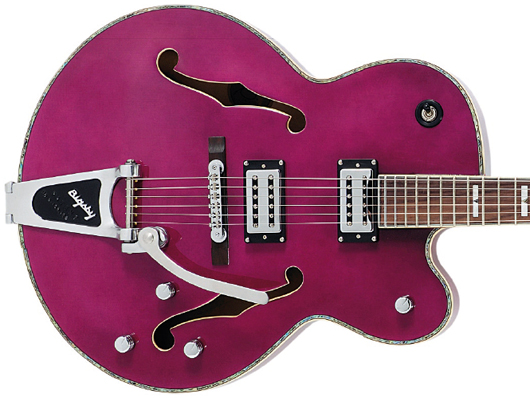
Peavey Rockingham B6 specifications
Spec
Price: £473 (inc case)
Origin: China
Body: Laminated maple with laminated maple top
Neck: Maple, set
Fingerboard: Rosewood
Hardware: Bigsby B6 vibrato, floating tune-o-matic-style bridge, rosewood base
Electrics: Two Peavey retro-styled humbuckers, three-way toggle pickup selector, volume control for each pickup plus master volume and master tone controls
Options: The hardtail version costs £354
Finishes: Trans purple (as reviewed), natural, sunburst
Next: Peavey Rockingham B6 build and features
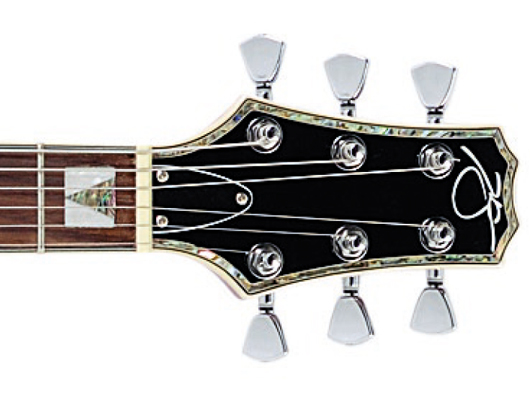
Peavey Rockingham B6 build and features
Build and features
With a rim depth of 65mm, the Peavey is the meatiest of the guitars on test and is almost in Gibson Byrdland/ES-350 territory for sheer cubic volume. The laminated maple body sports an unusual yet eyecatching trans purple finish and there’s even a reasonably generous strip of abalone binding to boot.
The finishing is a little untidy, but this is more than made up for by the traditional layout of the controls, with a master volume nestling on the lower cutaway as a complement to the two independent pickup volumes and the master tone.
As we’ve said, the look is vital in rockabilly styles, and we applaud Peavey’s efforts to ensure that the design of the two humbuckers are close to the appearance of the classic Gretsch Filter’Tron. A Bigsby B60 is available for wobble duties, alongside a floating tune-o-matic-style bridge fitted with traditional sharp saddles.
The Rockingham comes out of the box strung with flatwound strings, which are certainly an acquired taste to a certain extent, and we did re-string with roundwounds to level the pitch in terms of sound.
Next: Peavey Rockingham B6 sounds, pros and cons
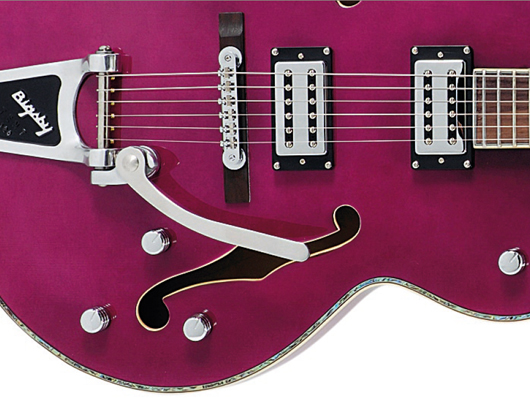
Peavey Rockingham B6 sounds, pros and cons
Sounds
Sporting easily the warmest tone of all the guitars on display here, there’s scope to utilise the Rockingham in both the jazz and rockabilly scenes. For full chords and single-note licks, your tone is full and very convincing, even though fatter semis such as this one rarely twang.
With no tuning issues to report, we found we could wiggle and waggle the Bigsby with abandon and, although the big body does get in the way of upper fret access, it’s a joy to both play and listen to.
Bridge then neck pickups:
Pros: Authentic looks; decent tonal variety; price, especially considering the included hard case.
Cons: Roller saddles would be nice.
4 out of 5
Verdict: If you’ve hankered after an affordable big-bodied semi, you must try this beauty.
Next: Ibanez Artcore AFS75T price and specification
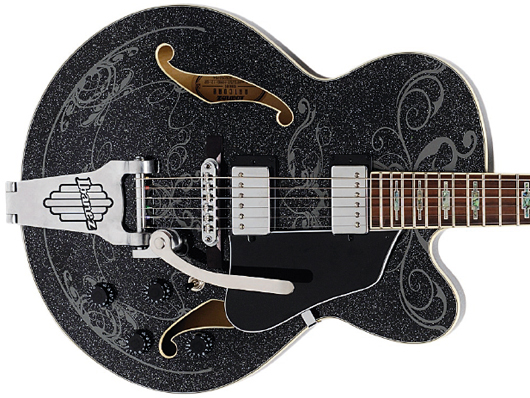
Ibanez Artcore AFS75T specification
Spec
Price: £389
Origin: China
Body: Laminated maple with laminated maple top
Neck: Mahogany, set
Fingerboard: Rosewood
Hardware: VBF70 vintage vibrato, floating tune-o-matic-style bridge with roller saddles, rosewood base
Electrics: Two Ibanez ACH humbuckers with three-way toggle pickup selector, two volumes and two tone controls
Options: The AFS95T with gold hardware and a flamed sycamore top costs £489
Finishes: Neo Western black (as reviewed), trans red
Next: Ibanez Artcore AFS75T build and features
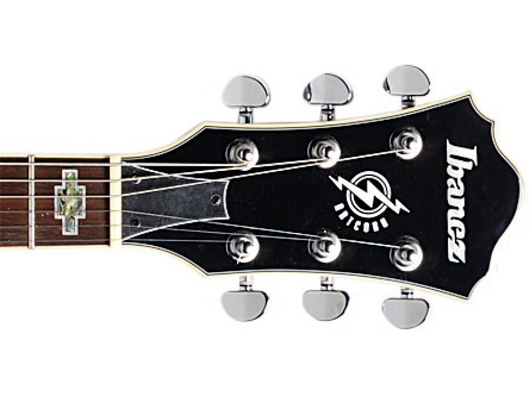
Ibanez Artcore AFS75T build and features
Build and features
This example from the ever-expanding Artcore range is among the best-looking slimline semis we’ve seen for a while, especially at this lower end of the market.
Not only does the Neo Western finish here include a black sparkle base, it’s overlaid by a decal of swirling gunmetal grey pinstripes. It’s perfectly applied and, as we’ve suggested, makes for a very pretty guitar: so much so that we were sorely tempted to remove the scratchplate.
Accoutrements such as the cool fingerboard inlays and the design included on the plate of the Ibanez version of the B70 vibrato complete the rather attractive picture. To assist with tuning stability the bridge - floating on a rosewood base - is loaded with roller saddles to allow, in theory, a smooth string movement back and forth.
However, we should report than the vibrato’s arm is extremely stiff and does tend to get frustratingly stuck almost a semitone out of whack: very annoying. Loaded with two ACH humbuckers, the four-knob panel is complemented by a three-way toggle sited in the same area.
Next: Ibanez Artcore AFS75T sounds, pros and cons
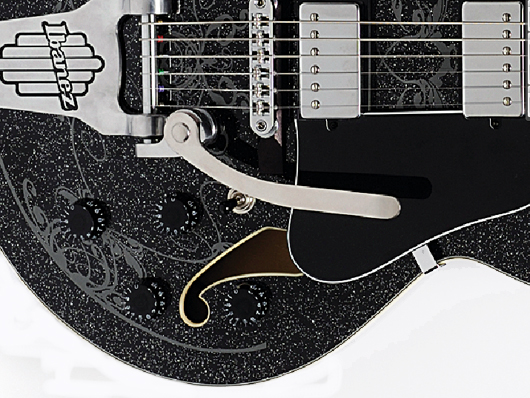
Ibanez Artcore AFS75T sounds, pros and cons
Sounds
The lack of a substantial centre block actually works to the Artcore’s advantage to a certain extent, as the bridge pickup does offer a degree of hollowness to its tone. For those slinky leads and full chords, its sound surprised us with its quality.
It reacts well with a touch of drive and is also more than good enough for any jazz toastiness to boot. In fact, if it wasn’t for that pesky vibrato continually throwing tuningrelated spanners into the works, we’d be totally enamoured with the Artcore.
Bridge then neck pickups:
Pros: Impressive look and vibe; tonal performance; light weight; price.
Cons: The overly sticky Bigsby performance.
3.5 out of 5
Verdict: This lovely looker is let down by a vibrato that’s virtually unusable. Great potential though.
Next: The verdict - which semi-acoustic guitar is best?

The Verdict - which semi-acoustic guitar is best?
Verdict
Even below £500, the build quality of semis manufactured from laminated maple has improved to the point where we’d happily gig any member of this foursome (so long as the Artcore’s vibrato was sorted).
What’s more, we’re confident that we’d be safe from derision from baying rockabilly crowds. On the face of it, the Gretsch seems the obvious choice. It’s very affordable, it looks very authentic and even though the tone is bereft of the required level of twang a Filter’Tron or DeArmond pickup would offer, the sheer performance level should satisfy even the most demanding fifties throwback.
After all, what fledgling rockabilly merchant wouldn’t want a genuine Gretsch? The Schecter Corsair is a double-cut that also boasts a hefty mahogany centre block and, if we’re being honest, it’s more suited to rock and blues styles than kinetic rockabilly.
However, it’s a truly gorgeous player that knocks the vast majority of Epiphone semis into a cocked hat. It’s also possible to obtain a spikier tone thanks to the provision of coil-splits.
As the chubbiest semi of this quartet, the Rockingham gives the warmest, fattest tone and, again, would be the perfect tool for jazz, even though the pickups are good enough to respond authentically to heightened treble settings. What’s more, its modest price tag, almost unbelievably, includes a fully-fitted hard case - now that’s what we call value.
Giving probably the most faithful fifties tone is the Ibanez Artcore and, with a slimline body and the coolest set of decal graphics we’ve seen in a while, it’s in with a shout of receiving our highest recommendation.
Sadly, the set-up made it all but unplayable and although we know enough about Ibanez to concede that this is likely to be restricted to our example, it’s a real shame.
We may have given the Gretsch the highest rating, but as each instrument here has its own voice and look, we’re certain that any of them will allow you to effortlessly open doors to rockabilly, jazz, blues and more.
Liked this? Now read: The best electric guitars under £1000
Connect with MusicRadar: via Twitter, Facebook and YouTube
Get MusicRadar straight to your inbox: Sign up for the free weekly newsletter
Simon Bradley is a guitar and especially rock guitar expert who worked for Guitarist magazine and has in the past contributed to world-leading music and guitar titles like MusicRadar (obviously), Guitarist, Guitar World and Louder. What he doesn't know about Brian May's playing and, especially, the Red Special, isn't worth knowing.